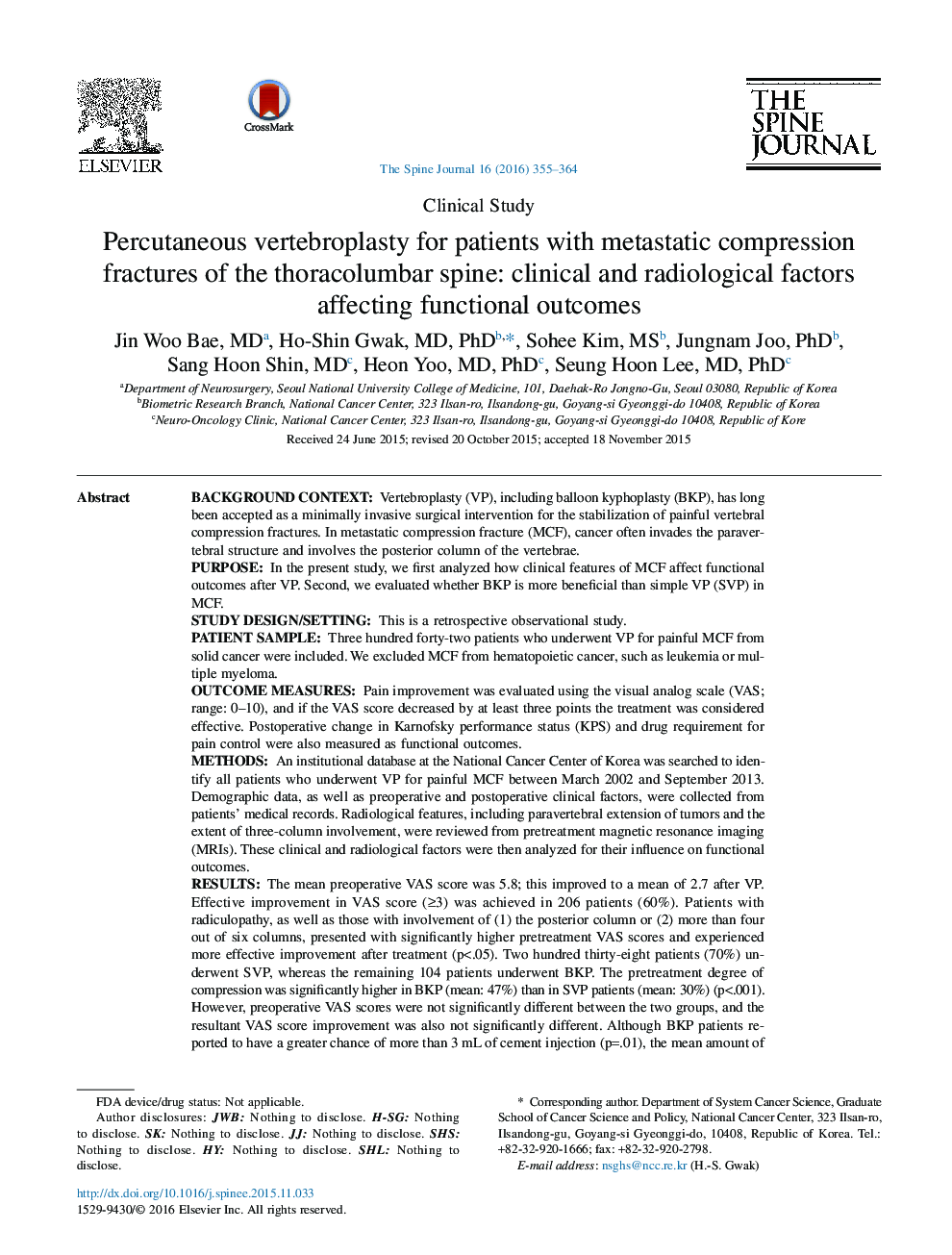| کد مقاله | کد نشریه | سال انتشار | مقاله انگلیسی | نسخه تمام متن |
|---|---|---|---|---|
| 4096294 | 1268556 | 2016 | 10 صفحه PDF | دانلود رایگان |
Background ContextVertebroplasty (VP), including balloon kyphoplasty (BKP), has long been accepted as a minimally invasive surgical intervention for the stabilization of painful vertebral compression fractures. In metastatic compression fracture (MCF), cancer often invades the paravertebral structure and involves the posterior column of the vertebrae.PurposeIn the present study, we first analyzed how clinical features of MCF affect functional outcomes after VP. Second, we evaluated whether BKP is more beneficial than simple VP (SVP) in MCF.Study Design/SettingThis is a retrospective observational study.Patient SampleThree hundred forty-two patients who underwent VP for painful MCF from solid cancer were included. We excluded MCF from hematopoietic cancer, such as leukemia or multiple myeloma.Outcome MeasuresPain improvement was evaluated using the visual analog scale (VAS; range: 0–10), and if the VAS score decreased by at least three points the treatment was considered effective. Postoperative change in Karnofsky performance status (KPS) and drug requirement for pain control were also measured as functional outcomes.MethodsAn institutional database at the National Cancer Center of Korea was searched to identify all patients who underwent VP for painful MCF between March 2002 and September 2013. Demographic data, as well as preoperative and postoperative clinical factors, were collected from patients' medical records. Radiological features, including paravertebral extension of tumors and the extent of three-column involvement, were reviewed from pretreatment magnetic resonance imaging (MRIs). These clinical and radiological factors were then analyzed for their influence on functional outcomes.ResultsThe mean preoperative VAS score was 5.8; this improved to a mean of 2.7 after VP. Effective improvement in VAS score (≥3) was achieved in 206 patients (60%). Patients with radiculopathy, as well as those with involvement of (1) the posterior column or (2) more than four out of six columns, presented with significantly higher pretreatment VAS scores and experienced more effective improvement after treatment (p<.05). Two hundred thirty-eight patients (70%) underwent SVP, whereas the remaining 104 patients underwent BKP. The pretreatment degree of compression was significantly higher in BKP (mean: 47%) than in SVP patients (mean: 30%) (p<.001). However, preoperative VAS scores were not significantly different between the two groups, and the resultant VAS score improvement was also not significantly different. Although BKP patients reported to have a greater chance of more than 3 mL of cement injection (p=.01), the mean amount ofcement injected was not different between the two groups. Patients with other bone metastases showed a significantly poorer KPS improvement rate (p=.015). Patients having moderately or slowly growing cancer according to the Tomita classification had a greater chance of reduced drug requirements 1 month after the procedure (p=.004).ConclusionsParavertebral extension and posterior column involvement of MCF did not preclude pain improvement after VP. Balloon kyphoplasty for MCF failed to show enhanced pain improvement relative to SVP. Metastatic compression fracture patients with other bone metastases or rapidly growing tumors had a lower chance of performance improvement and reduced drug requirements, respectively.
Journal: The Spine Journal - Volume 16, Issue 3, March 2016, Pages 355–364
